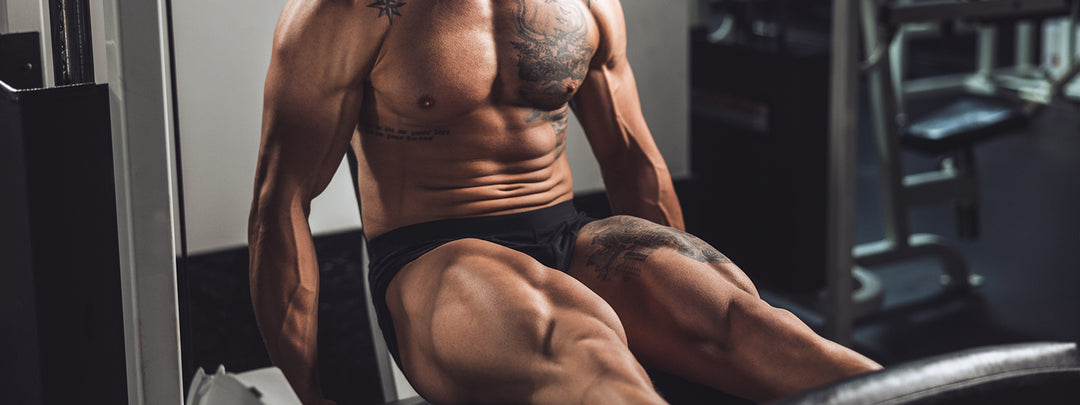FUEL FAT LOSS LIKE A PRO

Look around your gym during peak hours and chances are high that you'll spot someone almost immediately with big arms. Try and jump on a bench Monday night and you'll find out quick that there's some serious pec development going on.
How many of these same people though have abs? We're talking about ‘washboard’ abs that pop!
Not that many, right?
Ever wonder why?
The truth is that getting your body fat low enough for your abs to 'pop' is hard work. The reason is that there are so many different balls up in the air; training, cardio, ab work, diet, supps, hydration, recovery ... you name it.
You've got to have all your bases covered if you wana lift up your shirt to admire your abs in that good gym light.And one guy who has all those bases covered is MUTANT athlete Parker Egerton. You've got to know how to whip yourself into championship condition to the point where your abs are in; and your physique is lean, dry, hard and crisp. And you better believe Parker has that know-how!
So if you wana find out how to fuel fat loss like a pro, read on ... because if you don't, you might end up being a "tank-top" bodybuilder.
The Protocol
When it comes to goal-directed behavior, the old Military adage applies ... proper planning prevents poor performance. It's no different with fat loss. Think of this protocol as pieces of a puzzle that fit together to make a complete picture ... and that picture is of you; lean and conditioned with a six-pack!
Weight Training and Cardio
If you've been lifting heavy to build a solid structural foundation, now is the time to crank up the intensity to condition that muscle for that lean, hard, dry look. You can do that by altering your rep ranges and rest intervals between sets. So, your five sets of five on the bench with three minutes rest between sets gives way to five sets of fifteen on the bench with one-minute rest between sets. To do that, you're going to have to drop the weight, which is OK because remember, you're on a cut.

Training like this burns more calories and pushes a ton of blood into the muscle, which more than makes up for not lifting heavy. Try also incorporating drop-sets, super-sets and tri-sets. These intensity-boosting techniques also apply to ab work. If you're not one to train abs regularly, start now. Hanging leg raises, crunches and planks are up.
Aside from the extra calories you're going to burn with your weight training and ab work, you're still going to have to do cardio; anywhere from three to six times per week, depending on where you're at. And when it comes to cardio for fat loss, High Intensity Interval Training (H.I.I.T.) is the answer.
In a meta-analysis that compared Moderate-Intensity Continuous Training to High Intensity Interval Training published in the British Journal of Sports Medicine (2019), researchers concluded that "interval training provided 28.5% greater reductions in total absolute fat mass."1 That, combined with the fact that interval training gets your cardio done in a fraction of the time as compared to old school cardio, makes this one a no-brainer. Bottom line; interval training is the way to lose fat without having to slug through hours of cardio.
Diet and Supps
When it comes to the diet part of the puzzle, we're not gonna go full scorched Earth and break down every calorie to the gram. Rather, some guidelines are in order.
First, from a macro standpoint, the move is a high-protein, low-carb and moderate fat diet. In a study published in the journal Obesity (2013), researchers found that subjects who consumed a "relatively low glycemic load diet" had 11% less intra-abdominal fat than subjects who consumed a high glycemic load diet after just eight weeks.2 And how you implement that is by cutting the heavy, bloating carbs like bread, pasta and the like; replacing them with vegetables, especially the likes of celery and asparagus, which also have natural diuretic properties. Following this type of low-carb diet, good as it is for fat loss and conditioning, it doesn't come without it's challenges though. And one of the biggest comes in the form of a reduction in energy, which kind of sucks because you need that energy to fuel your training.
The solution to the problem of staying energized while following a low-carb diet is two-fold; (1) get a portion of your daily fat intake from Medium Chain Triglycerides (MCT) oil and (2) use BCAA THERMO.
MCT Oil
MCT oil is a type of fat that, because of its molecular structure, digests quickly. This makes it readily available for use as a natural energy source by the body. It's also been shown in research to play "a role in lowering weight, and decreasing metabolic syndrome, abdominal obesity and inflammation."3
MCT oil can be a game-changer when it comes to staying energized and getting lean, while running low carbs. MUTANT MCT OIL is sourced from free-growing coconut trees using an ultra-clean extraction process. It's also flavorless and odorless, making it the perfect addition to a shake. To try it, Click here
BCAA THERMO
BCAA THERMO is a metabolic amino acid fuel and Parker’s go-to supplement when he's cutting. It's a two-headed monster of a formula with an amino acid component ... and an energy-enhancing, thermogenic component. Batting lead-off is six grams of 100% plant-based Branched-Chain Amino Acids (BCAA's), which have been instantized for easy mixing and quicker absorption. Research published in Applied Physiology, Nutrition and Metabolism (June 2017) points to strength improvements stemming from supplementation with BCAA's, plus decreased muscle soreness and better recovery. 4, 5

This is key because in addition to dwindling energy when you're on a cut, the other two things to account for are strength decreases and increased muscle soreness; both of which make sense because you're restricting calories; so your body doesn't have the weapons to fight back. Supplementing with BCAA's can help you win the fight.
More research from a 2009 study published in the Journal of the International Society of Sports Nutrition found that subjects who took BCAA's throughout an eight-week resistance training program showcased less body fat and more lean mass, plus strength gains; as compared to subjects who took only a protein supplement, or a sports drink.5,6
Less body fat, more lean mass and strength ... and we haven't even gotten to the thermogenic component of the formula yet!
BCAA Thermo also includes 240 mg of caffeine anhydrous. Caffeine has a long history of use. Research as far back as 1989 indicates that ... "Caffeine at commonly consumed doses can have a significant influence on energy balance and may promote thermogenesis in the treatment of obesity."7 More recently, the European Journal of Clinical Nutrition (2009) reported findings of caffeine's ability to produce a thermogenic response of 6% above the baseline value, as compared to placebo.8 If that's not enough, the Journal of the International Society of Sports Nutrition (2010) concluded that caffeine supplementation is beneficial for high-intensity exercise and that it "exerts a greater ergogenic effect when consumed in an anhydrous state as compared to coffee."9
Further stimulating energy, focus and your body's fat burning machinery is the inclusion of CaloriBurnGP® in BCAA THERMO. One of the most exciting new ingredients to emerge in fat loss research over the last few years, CaloriBurnGP® is a natural extract of Grains of Paradise seed that has the documented ability to increase whole body energy expenditure.10
Taken as a whole, BCAA THERMO can be the driving force behind fuelling fat loss like a pro. To try it, click here.
The "FEW" Vs. The "MANY"
Listen, it's not going to be easy; anyone that tells you different is lying. There's a reason so few people are walking around with low body fat and a dialed in six-pack.
Many just throw in the towel after a few weeks and role the excuse dice; rather than face the truth that they just don't have what it takes.
Do you?
Are you one of the "few" ... or part of the "many?"
- fat loss
- tips & tricks
- to-go
- Weigh-in weekly, not daily.
- Take progress pics every 10 days.
- Track your calories with an app.
- Chew sugar-free gum to help blunt appetite.
- Opt for berries when it comes to fruit.
- Load up on green vegetables.
- Drink at least 2 liters of water per day.
- Sleep seven to nine hours per night
- Add apple cider vinegar to your plan.
- Use cheat meals (not days) strategically.
References
- https://pubmed.ncbi.nlm.nih.gov/30765340/
- https://pubmed.ncbi.nlm.nih.gov/23671029/
- https://www.ncbi.nlm.nih.gov/pmc/articles/PMC5805166/
- https://pubmed.ncbi.nlm.nih.gov/28177706/
- https://www.issaonline.com/blog/index.cfm/2019/amino-acids-for-weight-loss-do-supplements-work
- https://www.ncbi.nlm.nih.gov/pmc/articles/PMC3313152/
- https://academic.oup.com/ajcn/article-abstract/49/1/44/4716276?redirectedFrom=fulltext
- https://pubmed.ncbi.nlm.nih.gov/17882140/
- https://pubmed.ncbi.nlm.nih.gov/20205813/
- https://pubmed.ncbi.nlm.nih.gov/23308394/


